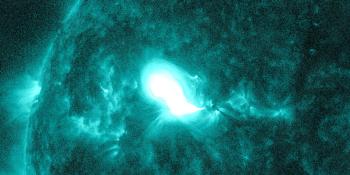Visualizzazione archivio di domenica, 11 febbraio AM
Rapporto attività solare
Ogni brillamento solare menzionato nel rapporto ha un fattore di scala, applicato dal Centro di Predizione Meteorologica Spaziale (SWPC). A causa del fattore di scala del SWPC, i brillamenti solari sono segnalati come ridotti del 42%, rispetto ai dati di qualità scientifica. Il fattore di scala è stato rimosso dai nostri dati archiviati sui brillamenti solari, per riflettere le unità fisiche reali.
Rapporto dell'Attività Geofisica Solare 2001 Feb 11 2200 UTCPreparati dal SWPC della NOAA© ed elaborati da SpaceWeatherLive.com
Rapporto Congiunto USAF/NOAA dell'Attività Solare e Geofisica
SDF Numero 042 Emesso alle 2200Z il Feb 11 2001IA. Analisi delle Regioni Solari Attive e Attività dalle 2100Z-10 alle 2100Z-11 Solar activity continued low. A C6/1f flare erupted
near the location of spotless plage 9346 (N18W80), at 0123 UTC. A
type II sweep and a halo CME occurred in conjunction with the event.
Region 9338 (S20W28) was still the brightest region in h-alpha, and
produced occasional C-class events. Some minor surging is occurring
at west limb near where Region 9330 (N22W91) is transiting. At east
limb, more impressive surging was seen to accompany the arrival of
newly numbered Region 9350 (N18E69).
IB. Previsione dell'Attività Solare
Solar activity is expected to be low.
IIA. Sommario dell'Attività Geofisica dalle 2100Z-10 alle 2100Z-11
The geomagnetic field was predominantly quiet to unsettled. However,
brief active conditions occurred from 0600-0900 UTC at Boulder from
a short-lived substorm. An enhancement in the greater than 10 MeV
proton flux at geosynchronous orbit began about 0600 UTC, following
the C6 event at 0123 UTC. The particle increase reached the 1 pfu
level, most recently at 1025 UTC, before the slow decay now
occurring, commenced.
IIB. Previsione dell'Attività Geofisica
The geomagnetic field is
expected to be quiet to unsettled. A glancing blow from today's halo
CME is anticipated mid-to-late in the forecast period, but the
impact on the field should be slight. The greater than 10 MeV
proton flux should return to background levels during the next 24
hours.
III. Probabilità dell'Evento dalle Feb del 12 alle Feb del 14
| Classe M | 10% | 10% | 10% |
| Classe X | 01% | 01% | 01% |
| Protone | 01% | 01% | 01% |
| PCAF | green | ||
IV. Flusso di 10.7 cm di Penticton
Osservato 11 Feb 151 Previsto 12 Feb-14 Feb 150/150/155 Media di 90 Giorni 11 Feb 171
V. Indici Geomagnetici A
Osservato Afr/Ap 10 Feb 004/005 Stimato Afr/Ap 11 Feb 007/007 Previsto Afr/Ap 12 Feb-14 Feb 005/005-005/010-010/010
VI. Probabilità dell'Attività Geomagnetica dal 12 Feb al 14 Feb
| A. Latitudini Medie | |||
|---|---|---|---|
| Attivo | 10% | 10% | 20% |
| Tempesta minore | 05% | 05% | 10% |
| Tempesta maggiore-grave | 01% | 01% | 05% |
| B. Latitudini Alte | |||
|---|---|---|---|
| Attivo | 20% | 20% | 30% |
| Tempesta minore | 10% | 10% | 20% |
| Tempesta maggiore-grave | 01% | 01% | 10% |
Tutti gli orari in UTC
<< Vai alla pagina della panoramica giornaliera
Ultime notizie
Ultimi messaggi dal forum
AR13901 11/25/2024 possible CME 28jsoc 17Nasa engineers meet “ smarter every day” 6Coronal mass ejection impact and G4 geomagnetic storm 10 & 11 October 2024 933>500 meV 24
Altri argomentiSupporta SpaceWeatherLive.com!
Molte persone vengono su SpaceWeatherLive per seguire l'attività del Sole o sapere se ci sia la possibilità di vedere l'aurora, ma a maggior traffico corrispondono costi maggiori. Considerate una donazione se vi piace SpaceWeatherLive così che possiamo mantenere online il sito web!

Notizie sul meteo spaziale
| Ultimo brillamento X | 2024/11/06 | X2.39 |
| Ultimo brillamento M | 2024/11/27 | M1.0 |
| Ultima tempesta geomagnetica | 2024/11/10 | Kp5+ (G1) |
| Giorni senza macchie | |
|---|---|
| Ultimo giorno senza macchie | 2022/06/08 |
| Media mensile Numero di Macchie Solari | |
|---|---|
| ottobre 2024 | 166.4 +25 |
| novembre 2024 | 145.7 -20.7 |
| Last 30 days | 151.4 -3.3 |


